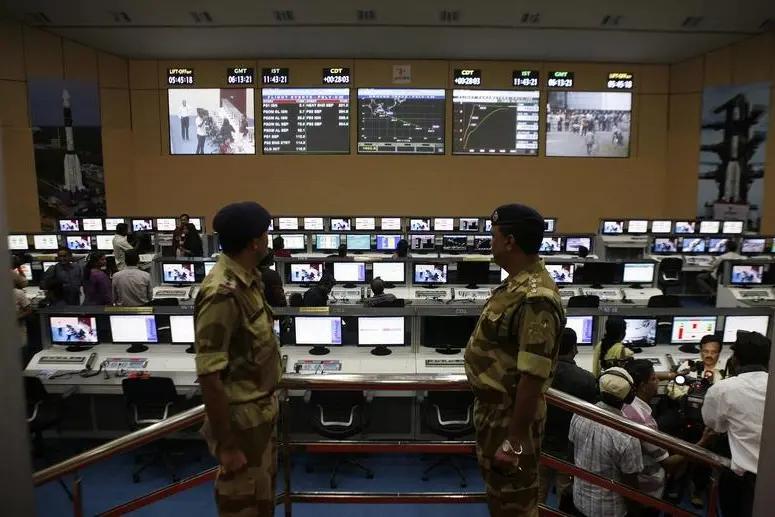PHOTO
Setting foot on the Moon on July 20, 1969, Edwin 'Buzz' Aldrin and Neil Armstrong changed the course of space exploration. In the 50 years since that dramatic event, there have been six crewed missions by NASA under the Apollo programme, and several more uncrewed missions by the Soviet Union, European Space Agency (ESA), Japan, China and India, which returned to Earth with samples from the surface of the Moon.
Recently, American President Donald Trump announced that the US was returning to crewed missions, not only to the Moon but to Mars and beyond. A new US Space Policy Directive called on NASA to "lead an innovative and sustainable programme of exploration with commercial and international partners to enable human expansion across the solar system and to bring back to Earth new knowledge and opportunities."
Signing the directive, President Trump said it "marks a first step in returning American astronauts to the Moon for the first time since 1972, for long-term exploration and use. This time, we will not only plant our flag and leave our footprints - we will establish a foundation for an eventual mission to Mars, and perhaps someday, to many worlds beyond."
In line with the directive, NASA is planning an "innovative combination of missions" with commercial and international partners, scheduled for the early 2020s to enable better understanding of the lunar surface in addition to readying it for a sustained human presence. The missions are also meant to use the lunar surface as a "crucial training ground" and as a "technology demonstration test site".
Meanwhile, China has also announced big plans for its own Moon missions. Even as space agencies around the world are applauding it for soft landing the Chang'e 4 on the far side of the Moon in early January, Beijing has revealed its plans for additional lunar missions that would set a firm foundation for a possible science and research base on Moon.
Clearly, the historic landing has given a huge boost to China's confidence in undertaking complex space exploration missions. The country will be launching a successor mission, Chang'e 5 towards the end of this year. And this is only the beginning.
China has plans to undertake an interplanetary mission to Mars sometime next year. Its ambitions also include building its own space station, Tiangong, or Heavenly Palace, by 2022.
Asia has other contestants in outer space. Both Japan and India have been eyeing the growth of China's military space programme under the leadership of the People's Liberation Army. The changing balance of power equations in Asia along with the troubled history among key Asian powers are likely to lead to competition in the outer space domain as well.
Even though China has reiterated that its space programme is a peaceful one, there have not been too many takers. On the contrary, China's achievements are driving India and Japan to cooperate with each other to keep up.
The India-Japan strategic partnership has been growing stronger, and this also extends to their cooperation on matters of outer space. The two countries recently announced that they will be holding their first space security dialogue in March this year. Until now, India has held a space security dialogue only with the US, which began only in March 2015.
So, the upcoming India-Japan space security dialogue is an indication of how comfortable Tokyo and New Delhi are getting with each other. The bilateral space partnership is also driven by the increasing alignment of strategic thinking in shaping a stable and secure Asian strategic order.
Though both Japan and India have pursued national space missions, including lunar ones, these have not matched up to China's space capabilities, funded by its deep pockets and Xi's strategic vision and leadership. This has led to some serious rethinking in both Japan and India. In fact, this prompted Shinzo Abe and Narendra Modi to underline the importance of outer space in their bilateral relations.
In September 2017, the two leaders applauded the deepening partnership between the Japan Aerospace Exploration Agency (JAXA) and the Indian Space Research Organisation (ISRO) on a number of important areas, including Earth observation, satellite-based navigation, space sciences and lunar exploration.
Clearly, lunar missions are back with a bang, as is competition for space laurels, much like the US-Soviet space race during the Cold War. But there is also a bit more to the race this time because space-mining and its associated economics have been gaining greater traction in recent years. Similarly, both India and China are making separate plans to engage in space-mining. Ye Peijian, the chief commander and designer of China's lunar exploration programme, has stated that the country will send the first batch of asteroid exploration spacecraft around 2020.
India has also been making a similar case. Prabhat Ranjan, executive director of the Technology Information, Forecasting and Assessment Council, a policy organisation within the Department of Science and Technology, has argued that the "Moon is already being seen as a mineral wealth, and further, one can go up to the asteroids and start exploiting this." He added that these are "game changer" developments "and if India doesn't do this, we will lag behind."
China's rapid advances and achievements in outer space means that there is a good chance of India, Japan, Australia and the US seeking to cooperate more. Such consolidation among key Indo-Pacific powers is a clear sign of the growing discomfort in the region with China's unilateral tendencies and approaches, not just in the space domain but in the broader strategic realm.
Rajeswari Pillai Rajagopalan is a distinguished fellow and headof the Nuclear and Space PolicyInitiative at the Observer ResearchFoundation, New Delhi.
Copyright © 2019 Khaleej Times. All Rights Reserved. Provided by SyndiGate Media Inc. (Syndigate.info).












